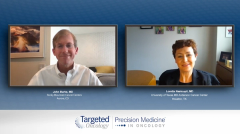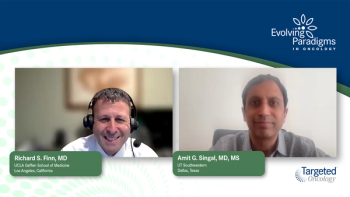
Treatment Approaches for Patients With R/R DLBCL
Loretta Nastoupil, MD, and John Burke, MD, provide insight into treating patients with relapsed/refractory (R/R) diffuse large B-cell lymphoma (DLBCL).
Episodes in this series

John Burke, MD: [Let’s] talk about relapsed/refractory [R/R] [diffuse large B-cell lymphoma (DLBCL)]. Can you tell us about your current treatment approach at The University of Texas MD Anderson Cancer Center for patients with relapsed disease, and how frequently do you see patients relapsing?
Loretta Nastoupil, MD: Generally, when we counsel patients even at frontline, we anticipate that we may see treatment failures as high as 40% after using R-CHOP [rituximab, cyclophosphamide, hydroxydaunorubicin, vincristine sulfate (Oncovin), prednisone] or CHOP-like frontline approaches. There are different time points when [treatment] can fail, and [these] inform some of our second-line approaches. [We’re particularly nervous about] patients with primary refractory disease who progress in the midst of frontline CHOP-like therapy or generally within 6 months of completing frontline therapy. We also have learned from the CORAL study, which looked at the preferred salvage regimen for patients—R-ICE [rituximab, ifosfamide, carboplatin, etoposide] versus R-DHAP [rituximab, dexamethasone, high-dose cytarabine (Ara-C), cisplatin (Platinol)], and the takeaway was that patients who [had progressive disease] within 12 months of frontline rituximab-containing therapy generally had a poor prognosis. For patients who [have progressive disease] beyond that 12-month interval, it's still not a good factor for R/R large cell lymphoma. Generally, my anxiety surrounding their prognosis is slightly less. With that in mind, [we’re quick to try to enroll] our primary R/R patients on a novel-based approach.
We had had 3 of the randomized studies looking at CAR [chimeric antigen receptor] T-cell therapy in that second-line space, [which] was our preferred trial option for patients with primary R/R disease or those [with disease] that progressed within 12 months. Outside of a trial, that's where we probably could spend some time discussing, “What is the best approach for these patients?” I generally will assess their fitness level, and if I have patients who I think are going to tolerate intensive therapy and potentially go on to targeted stem-cell transplant and high-dose therapy, I generally will still pursue salvage, even if my expectation is lower that they'll respond. That's been our traditional route to date. However, for patients who are unfit or frail, or I'm concerned they're not going to get to transplant, I might consider a more novel approach.
[Based on the L-MIND study data], we have tafasitamab and lenalidomide as a reasonable second-line option right for transplant-ineligible patients, whether [because] of comorbidities or frailty. Where I'm struggling the most is for those patients who are refractory to frontline therapy. My optimism surrounding salvage chemotherapy is low. But if they are fit and could potentially tolerate salvage chemotherapy, should I be altering treatment and pursuing tafasitamab/ lenalidomide because it has a novel mechanism of action? That's where I've been struggling, because those patients were also excluded from the L-MIND study. But I think that's an interesting area to discuss. What do you do?
John Burke, MD: My overall approach is similar. I think it's fairly well-established that we think about these relapse patients in two main groups—either they're transplant-eligible, or they're transplant-ineligible. In someone who's considered to be eligible for transplant, it's generally accepted that that's the most likely way to cure that patient, and that's the route you should go. Certainly, the times may be changing. We heard in a press release that there may be some data forthcoming, that one of those three trials you mentioned regarding CAR T-cell therapy may be demonstrating improved outcomes, or, apparently, is demonstrating improved outcomes.
That is hot off the press, and I'm not aware that many people have seen that data. Historically, our standard for those folks has been salvage chemotherapy followed by transplant. Then you consider how quickly a relapse is occurring after initial therapy, and you're more comfortable with giving chemotherapy to patients [with relapsed disease that] occurs at least 6, but preferably 12, months later. Those who have so-called “primary refractory disease” have a much less favorable outcome, because their cancer has relapsed really quickly. Then you have [patients] who are considered to be transplant-ineligible, possibly because of their comorbidities, performance status, age, personal preference, or distance from a transplant center. In those patients, we just had conventional chemotherapy. Over the last couple of years, a lot has changed.
Many new targeted drugs [have] become available, and those include polatuzumab in combination with chemotherapy, tafasitamab, and lenalidomide. Selinexor was approved last year, and, just recently, we have loncastuximab tesirine, a new antibody-drug conjugate. We suddenly have this plethora of options to offer patients who are not eligible for transplant or who experience relapse after transplant or CAR T-cell therapy. It is one of the challenges of managing these folks these days. But then, how do you do that, and how do you sequence these things?
Transcript edited for clarity.







































